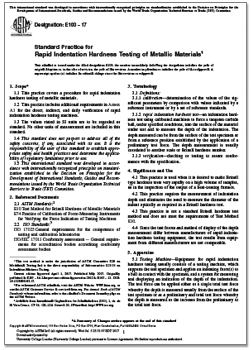英文名稱:
ASTM E103-17
Standard Practice for Rapid Indentation Hardness Testing of Metallic Materials
中文名稱:
ASTM E103-17
金屬材料快速壓痕硬度試驗(yàn)的規(guī)范
替代情況:
代號(hào)說(shuō)明:
This standard is issued under the fixed designation E103; the number immediately following the designation indicates the year of original adoption or, in the case of revision, the year of last revision. A number in parentheses indicates the year of last reapproval. A superscript epsilon (ε) indicates an editorial change since the last revision or reapproval.
版本說(shuō)明:
1 This test method is under the jurisdiction of ASTM Committee E28 on Mechanical Testing and is the direct responsibility of Subcommittee E28.06 on Indentation Hardness Testing.
Current edition approved April 1, 2017. Published May 2017. Originally published as E103 – 84. Last previous edition approved in 2012 as E103 – 12 . DOI: 10.1520/E0103-17.
2 For referenced ASTM standards, visit the ASTM website, www.astm.org, or contact ASTM Customer Service at service@astm.org. For Annual Book of ASTM Standards volume information, refer to the standard’s Document Summary page on the ASTM website.
3 Available from International Organization for Standardization (ISO), 1, ch. de la Voie-Creuse, CP 56, CH-1211 Geneva 20, Switzerland, http://www.iso.org.
標(biāo)準(zhǔn)正文:
1. Scope
1.1 This practice covers a procedure for rapid indentation hardness testing of metallic materials.
1.2 This practice includes additional requirements in Annex A1 for the direct, indirect, and daily verification of rapid indentation hardness testing machines.
1.3 The values stated in SI units are to be regarded as standard. No other units of measurement are included in this standard.
1.4 This standard does not purport to address all of the safety concerns, if any, associated with its use. It is the responsibility of the user of this standard to establish appropriate safety and health practices and determine the applicability of regulatory limitations prior to use.
1.5 This international standard was developed in accordance with internationally recognized principles on standardization established in the Decision on Principles for the
Development of International Standards, Guides and Recommendations issued by the World Trade Organization Technical Barriers to Trade (TBT) Committee.
2. Referenced Documents
2.1 ASTM Standards:
E10 Test Method for Brinell Hardness of Metallic Materials
E74 Practice of Calibration of Force-Measuring Instruments for Verifying the Force Indication of Testing Machines
2.2 ISO Standards:
ISO 17025 General requirements for the competence of testing and calibration laboratories
ISO/IEC 17011 Conformity assessment -- General requirements for accreditation bodies accrediting conformity assessment bodies
3. Terminology
3.1 Definitions:
3.1.1 calibration—determination of the values of the significant parameters by comparison with values indicated by a reference instrument or by a set of reference standards.
3.1.2 rapid indentation hardness test—an indentation hardness test using calibrated machines to force a tungsten carbide ball, under specified conditions, into the surface of the material under test and to measure the depth of the indentation. The depth measured can be from the surface of the test specimen or from a reference position established by the application of a preliminary test force. The depth measurement is usually correlated to another scale or Brinell hardness number.
3.1.3 verification—checking or testing to assure conformance with the specification.
在線閱讀 免費(fèi)下載







